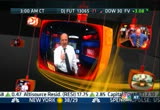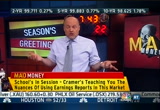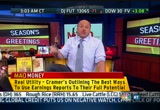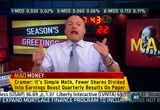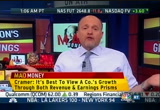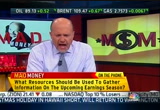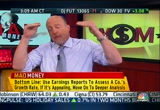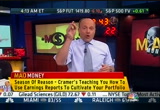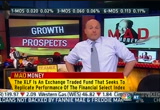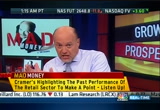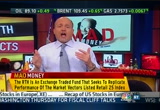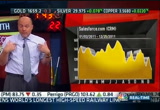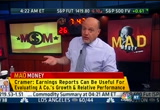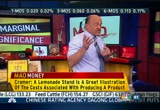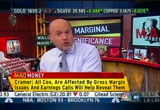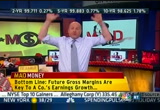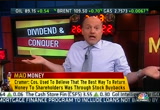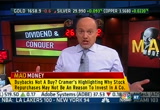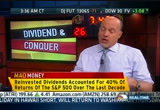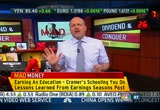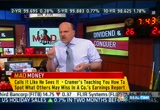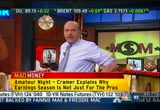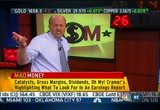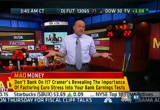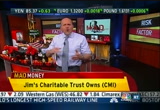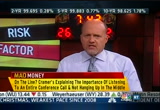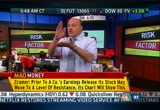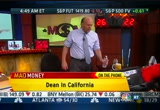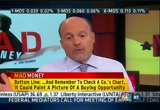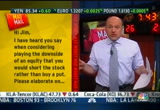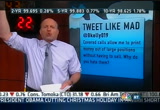tv Mad Money CNBC December 26, 2012 4:00am-5:00am EST
4:01 am
teaching you tonight. call me. earnings season -- earnings season -- i dread earnings season! why? because it is overwhelming with so many companies reporting at once and so much data being thrown at you. because it's hard to keep track of the expectations and to know what is better than expected. what the whisper, the real benchmark that must be beaten is. nah, huh-uh. it's because i have a bad back and i can't stand carrying all those printed out versions of the conference calls as a schlep from downtown manhattan where i do "squawk at the street" to the studio where i do "mad money." tonight i want to do something different. i got to help you this earnings season. i wanted to offer a new way to use earnings season, to put it in perspective. most of you watching are not day
4:02 am
traders that i think hijack a lot of the thinking. you're not trying to game a given quarter, something i true to aschew. and reports aren't accurate because of the things in europe or something involved with the election. in other words, other than those shorting or going long stocks ahead of the quarter, these earnings reports need a context to make you money. they can't be relied upon any more because they aren't as predictive of future behavior as they once were. they are a piece of the puzzle. a part of the mosaic. but they are only one of many important parts of what predicts where our stock will go over the intermediate term. and that tends to be the focus that i teach on the show. it is a teaching show because i want you to know the metrics i'm using to pick stocks i talk about and recommend here. and with my travel trust which you can follow along. i also want to teach you how to listen to these conference calls, listen to the
4:03 am
transcripts. at least give economy opini-- g you my opinion and what i think matter. i hope this show once and for all -- because this is what i see on twitter constantly -- use earnings season as a way to evaluate your portfolio, what to trim, what you need more of. hone your way of thinking. not mine but yours. earning season's incredibly important for what it tells you about issues four times a year. big report cards. not just the trajectory of the estimates. we're going to flush that out. i'm tired of the estimates bumped a penny or two. that's not making anybody any money. we can't dismiss earnings season. that would be total. we've got to put -- that would be totally wrong. we've got to put it in context. first, i assess them for predictive value for the year. i try discern where analysts go with their estimates after the companies' reports. do they raise them, lower them, keep them the same. say apple issues a report that is better than not only the
4:04 am
posted numbers that you find on web sites, but also beats what is known as the high man -- some call it the whisper, i think that's wrong. the high man. the analyst with the most aggressively high estimates on the street. that beat will cause a raising of numbers for the year by everyone. or if it is the end of the year, for the numbers in the year after it. i use that increase in earnings per share, the ones they use to bump it, to figure out several things. first, i try to figure out the increase from real business, actual sales did. they do better. and not just accounting change and share count changes. the latter fools a lot of people. to do what i like to do i look at the revenues than the earnings themselves. why is that important? because the company can't change the sales line except by increasing demand, producing more, gaining more customers, either at the expense of others or through better salesmanship, execution, and customer acquisition. they're making a better job, they're working harder. they're working it better. but a company can easily change the earnings by buying back a ton of stock. not the sales line, but the
4:05 am
earnings. it simply changes the number of shares, while keeping the numerator, profit, static. revenue growth in the quarter, particularly the holy grail. accelerated revenue growth, arg. quarter to quarter and year over year drive my thinking. they allow me to figure out future revenue and earnings source. that's what i really talk about the show. that allows me to figure out what to pay for the stock in the future. lot of people examine the price-to-earnings multiple in stock to make a determination of the stock's worth in what i call the p.e. vacuum, price to earnings mobile vacuum. they see a stock that sells at 20 to 30 times earnings when the average sells 11 times the s&p and say it sells more than the average stock. lazy thinking. you need to figure out what the growth rate is using the formula i laid out. find out how companies grow in the link quarter, the previous quarter, and the current one and the year-over-year quarter and calculate that trajectory versus growth rate.
4:06 am
let's put it simple. if a company is 20% and the price to multiple is double the earnings per share is 20 less, you probably have a bargain. we call that using the p.e.g. ratio. again, fundament of the show. a much more important ratio than the price-to-earnings multiple because it puts it in context that you can use versus other stocks. we're always comparing stocks. i'm willing to pay the multiple that may be up to twice the growth rate of the company, especially if there are very few companies growing that fast. meaning there's a scarcity value of companies. paying 70 times earnings for a company growing at 40% begins to get me nervous. even 40% growth is hard to come by. that's nosebleed territory. there are too many things that can go wrong with the stock when that happens. the converse is true, too. when i see a stock that sells for less than one times its earnings per share growth, i begin to salivate. unless there are other factors going against it, the factors that we covered in the rest of
4:07 am
the special show, i'm drawn enough to the stock that i have to find other reasons not it buy it. i'm on line, i use the actual earnings per share reports to figure out the growth rates of the stock. and if the growth rate is high and the price-to-earnings multiple paced on the future projections is equal to or less than twice the growth rate, then i'm interested enough to proceed with the rest of the work that this special show will detail. i need to go brad in south carolina. brad? >> caller: hey, jim. i want to give you a big boo-yah to you. >> wow. ago. that's aggressive. i'll take that. go ahead. >> caller: jim, i'm wondering how to best prepare for this earning season in tomorrows of online research resources. give me the inside scoop of what your browser will look like as you stay on top of all the market updates. >> okay. what i like to do -- first of all, i like nbc is. i'm not kidding. cnbc covers earnings better than
4:08 am
anyone. i use the web sites. they're so, so good, they have analyst reports, projections. i look at the news stories to get a sense of what the consensus is. then i look at analyst reports the day after. all that has to be done if you're going really sink your teeth in and feel very confident. start with the web site of the stock. to darrell in california, please. darrell? >> caller: yes. boo-yah, jim cramer. >> boo-yah! >> caller: i have a question there. what is meant by a reverse split stock? >> that means if there's a million shares, you know, say they do a 3-1, you know, they get to 300,000 shares. what is typically gone, ci citigroup did it. if you have 300 billion shares, you divide by three, you get 100 billion. it does raise the price, but it's illusory. you just have fewer shares. tyler in florida, please? tyler? >> caller: i'm going to give you a south florida boo-yah. >> i'll take that. i need to go there now. always. what's up?
4:09 am
>> caller: sun is shining -- actually, no, it's overcast. quick question. when you talk about the economy, you know, really booting off again, it seems like you talk about it in terms of consuming and not producing. i'm thinking from the way i think about it, you need something to be produced before it's consumed. i'm wondering why -- in terms of a growing economy you talk about consumption instead of production. that's what it seems like to me. >> i do because in order to be able to raise price, you need demand. if there's a shortage of supply, sure, that can mean something. but not if there's no demand. right? if you have a shortage of supply of some product that nobody likes, you can't raise price. doesn't mean anything. that's why we focus on demand on the show. a company has got their earnings stars before you buy it. okay, use the eps to figure out a company's growth rate, and then take it from there. we'll be right back. don't miss a second of "mad money."
4:10 am
4:13 am
cramerica, wishing you peace and prosperity from all of us at "mad money." welcome back to "mad money's" special earnings season companion show -- how not to be overwhelmed by earning reports and put them in perspective so you can profit from them in an informed and confident way, make money at home. we went over how i use earnings reports to figure out the growth rate and relate it to the stock price to figure out if it's too expensive or too cheap against its sector and the rest of the market. the next way i use the earnings report is equally as important. in some ways because of what i call the etf-zation of the market even more than the earnings per share. i measure the earnings growth and earning growth against its cohort and figure out -- here it is -- the whole cohort is worth
4:14 am
owning or forgetting about. that's right. for most of my more than three decade of investing, i have accepted the fact that the sector's important when you're picking a stock, it matters. historically a stock's sector has kaucounted for as much as me 50% of performance. now because so many people trade through efts and because they're popular for individuals and, more importantly, hedge funds to take quick action, the sector has superseded earnings at times. i got to tell you, often, it's made earnings all but an afterthought for individual companies. take the way that banks traded the last few years. i mean, it didn't matter for the most part whether a bank had strong earnings or weak earnings, did a good job or bad job. the bank was in the xlf, the financial eft, and people didn't want to own the xlf. it didn't matter how well a bank did. a bank like wells fargo, u.s. bancorp, u.s. bank in europe and strong managements, jpmorgan, morgan stanley, tremendous exposure to the continent. that's why at times i've had to
4:15 am
dismiss the earnings per share gains entirely at the moment if the cohort was radically out of favor. but i never just forgot them. instead, i tried to choose, figure out which ones can at times break the tug of the sector, the gravitational pull, and which can shine. if the second forfal-- sector falls, i got to be ready. since the march bottom of 2009, generational, we've seen retail and individual stocks within the sectors outperform. i like it listen to the earnings calls of all the retailers. at given times, i am wrapped by the groups doing the best. by far, the top performers during this period have been the discount stores. particularly the dollar stores. notably dollar general, d.g., and dollar tree, d. t. when i see the retail, i go back to my earnings report memory and reach for these two because they have the most earnings momentum. i know that because i keep listening to the calls even
4:16 am
though the group may have been out of favor of late. when you look at the retail eft, i use the rth, i am there with the ones with the best momentum. similar, i have looked at ross stores, t.j.'s, and bed bath and beyond had they grab a sector because they have the most inexpensive earnings momentum. there's another strategy for more sophisticated investors, too. when i know which are the best of the best in terngs of earnings because i focus on the calls and a muj hoont of money was poured into a given -- a huge amount of money was poured on into a given sector, i might sell the eft and buy the best performers according my earnings per share work. that way if it turns for the worst, we get a huge macro number that hurts or get weakness out of europe, i can lose less than people just playing the earnings momentum game because i own the best, and i am short the rest. sector analysis particularly important technology. people confuse this group of
4:17 am
stocks constantly. tech is actually a whole group of sectors, semiconductor -- semiconductors, hardware makers, cell phone, tech, telecommunications tech, infrastructure stocks, assemblers, each has a separate growth rate. here i look to look at the earnings per growth rate shares of companies i follow versus individual slices of the sectors. the sector growth rate doesn't work even though people keep trying to use it. cloud stocks are highly valued meaning the price to earnings to growth rates are extreme. that means there's no room for error or hair as we call it, meaning something is wrong, some chink that could upset the growth rate. in 2007 my favorite sales.com reported a magnificent quarter but the growth was lighter than expected. it got pancaked, why? it underperformed its shoergz of the technology sector even as the growth rate would have been outstanding for a personal
4:18 am
computer-related stock, disk drive, semiconductor, or cell phone companies. these days knowing what the sector is isn't enough. you need to know the subsectiontor. you need to know how your company stacks up against the growth rate of that subsector and know if it's in favor or isn't. the bottom line, nothing's worse than owning a bad stock as defined by weak earnings and bad sector neighborhood. nothing's better than earning a good stock in a great neighborhood. if you do not measure the stock's earning again the sector's growth and do not determine first whether the sector is in favorite versus out of favor, then the earnings report, better than expected or not, won't mean a thing. when we return, i'll give you several more ways to use earnings reports in the context of stock picking. not just trading, which i have come to see as pretty much a zero-sum game. stay with cramer.
4:22 am
keep up with cramer all day long. follow @jimcramer on twitter and tweet #madtweets. tonight we are talking not about who just reported better than expected quarter, getting excited about that. something we get caught up in during every earnings season. but how do you use these reports to put together the ideal portfolio for the long term? not for tomorrow's trade. we've established the importance of those reports for what they tell us about the growth of a stock and where it fits inside a sector, as well as the sector's gravitational pull that can overwhelm even the best earnings reports. hey, best house, bad neighborhood, neighborhood wins. but now we've got to dig further than the headlines to discern what else on the conference call or in reaction to the call can help us make some money. we don't stop with just a call. what else is important to listen to? the wall street analysts would tell you that the most important concept, the most important
4:23 am
predictiontor of future earnings is the gross margin. what's left after the cost of sales is subtracted? i like plain gross margins in a way any kid can understand, the lemonade stand. the cost of goods sold there are simple to understand. the lemons and, yeah, sugar. you figure out how much those cost, you you is traub it from what you -- you subtract it from what you owe, gross margin. the time it takes for the table, the sign, the people behind the stand, labor, equipment, the times you pay someone besides yourself to man the stand. same for publicly traded businesses. we try to figure out the cost of goods sold, whether they're going up or down. that's the inflation/deflation component. how much the labor costs, very important in a rising salary environment. how much leverage there is. meaning, if you have all of the labor and costs accounted for, how much business can you do? all right, the one i like to think of is not a lemonade stand but is pretty well known, chipotle. they have legendary fabulous gross margins. they have labor and food and customers. the more customers they can serve per hour, the more
4:24 am
leverage they have. the keys to the gross margin in chipotle are the cost of the guacamole, beef, tortillas, labor, and most importantly the number of customers they can push through in a given day. of course, there are dozens of other inputs advertised and leases to the stores. they need as little turnover as possible because the cost of training new employees is tremendous. a huge obstacle to making a lot of money. the former ceo of costco made it clear to us on man occasions on this show. in fact, he was legendary for paying his employees the most and treating them with the best of benefit because it's so important to keep them happy. so the firm doesn't constantly have to train new people. new people were not known to the regular customers who like to see the same old hopefully smiling faces. new people cost too much money. same goes for chipotle. with the most talented people are given promotions and opportunities to run more stores. mcdonald's, similarly. often praised for gross margin improvements. by the way, because it has the best market muscle, it can get low-cost goods and has good
4:25 am
leases. but also because it has the technology to innovate on a quick sail. one, it does not befudle its employees. and gross margin plays a part often in different ways. often the key to the gross margin has less to do with the cost structure of the company and more to do with the inventory conditions of an industry or given company. now we're talking tech. semiconductor companies, for example, often produce flat out, making as many shifts as they can 24/7. at times, end demand wanes, and the supply chain gets overwhelmed, glutted. in order to move more inventory, chip companies often have to cut price which lowers their gross margins and makes earning too volatile to predict. therefore, too powerful given a high priced earnings multiple. that's when you see pretty announcements is when there's too much inventory. we like companies with consistent growth and pay higher multiples. we don't like that inconsistent growth that tech gives us and pay lower multiples for them. used to pay high multiple for tech but no one could handle the
4:26 am
inventory glut that happens once or twice a year. same with steel and aluminum, they should be lumped in with tech. at times they're producing too much. at times products from other countries including china gauze a glut in the system. earnings get slashed. i listen closely to commodity calls to get a sense of whether inventory is building anywhere in the system. if it is, i can tell that the gross margins are coming down. and i got to get you out of those stocks. quicker that i do, aluminum, steel, copper, i got to work faster. don't you believe that it's just the commodities affected by the gross margins issues. i listened to every pharmaceutical call and hear about generic competition and what it may mean for future earnings. a drug company with a patent cliff meaning as drugs coming off patent will plummet in price scares me. and i tell you to get out. i think it's going to trade at a low multiple to future earning even if it traded as a high one in the past. until a stock discounts that, i got to keep you out of it. few drug companies are imean.
4:27 am
i steer clear as best i can until everyone knows about the patent cliff. then i go back. finally oil and service companies. these are hardest, difficult because you often have to figure out several numbers for the gross margins, how much it costs to drill, to get in and out of the ground, to ship and refine it. these are complicated companies. many companies in the industry have tried to break themselves up to make it easier for guys like me to figure out gross margins instead of having to be a blend that i got to unwrap. i care chiefly about finding costs and about end market prices. that's why the natural gas companies, for example, trade at a discount to the pure oil companies because the end market price of natural gas has just been so low for so long, and the end market price of crude has opinion high for so long. that's what dries me toward eog or continental. both with chief finding costs for oil. and expensive prices when they get it out of the ground. the bottom line, the key component after finding the earnings per share trajectory
4:28 am
and growth related to the cohort is to figure out the future gross margins. something that is uniquely calculated only by listening to the conference calls. can't get that in the headlines or any of the press reports. if you don't know the direction the gross margins, you won't know the direction your stocks are about to take in your portfolio. it is an integral part of the homework. if you don't calculate it yourself, you got to get it from somebody. read from the analyst who do. brad in ohio. >> caller: boo-yah from gerard, ohio, jim. >> gerard, ohio, got to get there. haven't been there yet, i'll get there. promise myself. >> caller: thanks for taking the call. as an investor interested in retail, i understand the fourth quarter is the most significant in earnings. how should one evaluate the first quarter earning? >> you know, i'll go back to the rules in my hedge fund. i don't care about the first quarter for retail. it's only the fourth quarter i care about. first quarter's not meaningful enough. you only have valentine's day during the quarter. i know this because my dad sells
4:29 am
-- gift wrap, okay? gift wrap is one of those things where you realize what the seasons are and valentine's day doesn't move the needle like christmas. so i like the holiday season, hanukkah. what i try to do is say, okay, i'll make my judgments from retail on the fourth your. i don't make any on the first. it's all that matters. i wait to hear the quarters and make my judgment for what the next year will bring. mike in illinois, mike? >> caller: this is mike in the windy city, giving you a chicago bears ba-ba-ba boo-yah. >> bears are constant. what's up? >> caller: if i'm short a stock, how long do i have to cover the short? >> forever. forever. that's one of the great things about shorting. stay short for as long as you want. remember, if the stock goes up, they may ask you to put more money up, though. that's where people get squeezed. okay, you got to dig deep if you want deep profits. gross margins will guide you in figuring out the direction of a stock. some things you only find on the conference calls, not the headlines. gross margins, that's on the call.
4:30 am
stay with cramer. nobody is more passionate about the market than i am. nobody in this whole country! >> i wanted to thank you. you have saved my retirement. >> you are why i come out here and do this show. thank you so much. >> caller: the stuff that you're doing for all of us is so important. i want to say thank you. >> caller: my husband and i watch every day, and we count on your help for small investors like us. >> put cramer's 30-plus years of experience to work for you. "mad money."
4:34 am
expected earnings report to do a good trade, seems to be a dominant way of thinking, but how to put the reports to work for you. select the best stocks and prune those that need to go. talking longer term respect. we figured out how to compute the growth rate of a company and whether it's too expensive based on the growth rate, somethi something @jimcramer. that's answered. we where w looking at the sector analysis as part of the rns report and focusing on gross margins, something that can only come out of the conference call. we must address two more pieces of the earnings puzzle, dividend growth and home run potential. from pretty much the time since i first bought stocks to the late 1980s until fairly recently, dividends were an afterthought. ever since i had my hedge fund. companies became einvestmentored of buybacks as a way to return money to investing shareholders. to me it's oxymoronic. as returning money for cher shareholder except in extreme cases, auto zone work, novellus,
4:35 am
are the executives paid for hitting earnings-based targets. they do that by shrinking the float through buying back just enough stock to make it so when the share count is divided into the earnings per share, well, it beats the compensation benchmark that they were supposed to hit. only a very handful of buybacks do what they're stopped do. that is make it so there are fewer shares out there. something that can drive a stock higher if the earnings are really scent. the buyback that accomplishes that goal, i got to tell you, count them on one hand. most buybacks appear to be a huge waste of money as companies spend a gigantic amount of cash buying stock when prices may have been appreciably higher because they don't know about stocks. they only know about their own business which is fine. what should they be doing? what are the good companies doing? they're offering more and more bountiful dividends. something that is a much better sign than management believes in the future than a buyback. buybacks are indefinite. cable being reined in. dwrends a declaration of
4:36 am
long-term confidence. now that low rates have been upon us for some time courtesy of fedex, used to store gasoline on the smoldering economic embers, dividends can provide a rate of return that certificates of deposits that you keep trying to make money with can't. of course, stocks present more risks than cds, they can go down but can go higher. that's often the case with companies that continue to boost dividends year after year. and if you reinvest those dividends, you can augment your return to the point where you are far exceeding a return on bonds. dividends are so important, they've been responsible for almost 40% of the s&p 500's return the last ten years. they're also the main reason why the dow industrial average with its above average dividend yield far outperformed the s&p 500 in 2011. 5.5% return for capital appreciation. how about making a total of 8% if you reinvested the average dividend. and the only thing you should be thinking of when you talk about benchmarks is reinvesting dividends. cash in your pocket. a safety net during the bad times, and a trampling in the good. so what do the earnings have to do with dividend component that we so often seek on "mad money"?
4:37 am
simple. we listen for calls that tip management's hand on the dividend to tell us there's enough excess cash available to boost that dividend. perhaps several times in a short period of time. that's what we heard from general electric in 2011. it signalled -- on every conference call they mentioned it. conversely, if a company signals the desire to buyback more stock and it's ineffective reducing the share cap, you foot to look at the year before, year before, you assume it was all about management enrichment unless proven innocent. they're seeking to contain the damage from the shares and options offered to management. a lot of tech companies do it, i regard it as disgraceful. no one else thinks that, i don't care. i know what i see. these days if management doesn't indicate it must boost a dividend on an earnings call, count me out unless the company has such ferocious earnings power, a la apple, that i'm willing to overlook it. we need to look for something
4:38 am
new in a call, something a company will announce that can serve as a catalyst. i talk about catalysts in the show. you need a catalyst to buy a stock. i scrutinize calls not so much for what has happened, that doesn't interest me. but something that will happen. and if i hear something that sound like it could propel the stock in the future, i am anxious to buy it. and if there's a sell-off because someone's disappointed the company didn't beat the estimates by enough or guide high enough to please the momentum funds of the stock, i got my opportunity. what are the examples i look for? pharmaceutical companies, they often telegraph what might be going into stage three, okay. meaning what drugs might be in your final approval. they often tell you about expanded usage on label for drugs. all regen, one of the best performing throughout the years, has told you more about the future than any other. it has been a terrific buy. every time it sells off after earnings because of this upcoming catalyst, it's constantly doing it. by the way, celgene. same, their call tells you what's coming up.
4:39 am
tech companies often tip their hands about upcoming product cycles. initiations that could make a huge difference in future earnings. pipeline companies, key creators of dividend wealth that we talk about all the time. they tell you about upcoming expansions that could be addtive to earnings. the exploration production companies almost always tell you what prospects they're looking for. when you might hear some really good news on these calls. i always file those comments away and wait for oil futures to go down. then i can start buying oils. that happened with continental resources, clr. gave you a chance to get in before it raised guidance for new finds later in the year. we had gone to the bakken. they are talking about how the storms that kept their drilling down, that the storms ended. nobody cared. then the stock took off when they told you that business is big and booming. the bottom line -- we look for signals about the future of these calls. particularly about upcoming catalysts that will move the stocks later on. making them solid buys on any short-term decline because it wasn't better than expected. try to measure confidence about cash flow that could ultimately trigger rising dividends.
4:40 am
the best source of wealth that stocks can give us. remember, dividends pave the way for thing to get better. there is no better way to find out about the prospects for increased dividends than to listen in on the earnings calls. stick with cramer. from our family to yours. happy holidays, cramerica. peace and prosecutes parity from all of us here at "mad money."
4:43 am
signature on the sidelines because of the uncertainty in the markets? >> thanks for turning my portfolio from mean to green. >> that's what i want to hear. >> with over 25 years experience in bull and bear markets, let coach cramer show you how to play to win. >> thanks for keeping us in the game. >> "mad money," weeknights on cnbc. earnings season doesn't have to be a gatling gun for numbers. only an attempt for hedge found profit from. tonight we've shown how you can look for signs of what to do with your portfolio over the long run because the earnings reports and the subsequent conference calls, the crucial thing, look -- here's the deal,
4:44 am
they don't have to be shoot first, ask questions later experiences. actually, the opposite. conference calls are ask questions, ask questions. and then ask some more questions. only then maybe take action. we are asking specifically about what the growth of the earnings per share might be and how expensive that would make the stock versus other stocks in the sector and maybe other stocks as a whole, usually regarded as the s&p 500. we wanted questions answered about gross margins and whether they'll be increasing, allowing us to judge if earnings estimates might be beaten in the future. we are looking for signs that dividends, these days the most important indicator of a company's health, might be boosted. we're looking for catalysts that could propel a stock higher or after earning season is over. data points, something big that will happen. that's important when stocks sell off in kneejerk fashion. because some company didn't beat somebody's estimate that might not have been informed anyway. there are two more items to be gleaned from these reports and conference calls, and they are
4:45 am
new ones that i've had to add to the equation because of structural change in the stock market over the last few years. the first is geopolitical risk. never cared that much about it because we're following american companies, america was king. geopolitical risks link exposure. looking for linked exposure. not just to the rising price of oil, that can be jostled by the middle east. that's always been an issue. linked exposure to the sovereign debt and banking debt of europe. we need to ask ourselves about how much exposure there might be for a given company to the chinese economy. for example, for most of 2011, it was impossible to own bank. they were perceived to have links to the troubled euro and its akurtdments. we tried to vacuum them from europe, the italian bond market or overstressed french and spanish counterparts. we got our heads handed to us. similarly, owning tech -- when tech is often to be considered heavily dependent upon europe. hey, come on, as much as 20%, 25% of earnings from tech are derived from the continent. typically it's been deadly. we know this because the business don't dodge in on the
4:46 am
conference calls. that's how you learn about it, people. the analysts won't let them get away with. listen to the q&a. at the end of the call if you are in a company with european exposure, you'll hear one out of every two or three questions about europe. asia, one out of every two questions about china. just too hard a steeplechase to go through. you want preventive earnings season medicine, go through the previous calls of the companies. if the questions are, say, but europe, you know you're probably going to be in for a bruising next time. that's what the analysts are focusing on. that's what they're forcing the companies to talk about. as correlated with europe as many tech and bank stocks are, it's china that controls so many of the cyclicals, smokestack companies. go listen to the earnings calls of caterpillar, joy global, incumbenti kins. peabody, vail. rio pinto. it's like owning a piece of the great wall of china. you want to be in them when the great wall is crumbling. such a pervasive worry that i've seen down grades of stocks like
4:47 am
yum because it's got a huge chinese business through kfc. and coach which has been expanding aggressively in china because of worries about a slowdown. can you imagine a kfc? similarly, owning a steel company without paying attention to what the chinese are dumping in their market is like taking a financial life in their own hands. how do you find out? companies as diverse as corning, 3m, ppg march to the beat of the asian drummer. you're not going to see it in the release. it's all in the pestering by analysts. pretty simple. listen to the call. and don't hang up until you've heard the last questions. you can read the transcript, so you can tell how worried the analysts are about the market that's didn't move the needle a few years ago. one final piece of the earnings puzle which is incredible. this is the earnings seasons that you have to weather something that i never talked about before, okay. we got to do it this before we're done for the night. one that's become obvious to anyone who watches regularly. can't believe i have to do this. i'm a fundamentalist, but i'm going to say. you have to know the chart of a stock ahead of the quarter. so often we have charters that are off-the-charts segment that
4:48 am
trace out where a pattern might be, where a stock could break down or break out if it hits a certain level. why is this so important? you got to recognize that the chart is the expectation game in picket graph form. when you hear that expectations were too high going into the quarter and that's why stocks sold off, you have to recognize that the chart was the gauge of the expectation. you look at the chart, that tells you where the expectations are. often a chart rallies a particular level in advance of the quarter, simply to what we call level of resistance. if the quarter isn't up to snuff, the stock can get hammered because of a charted failure. i don't want you to react to this kind of chartmanship. use it in your favor which is why i saved this chart take for last. you know what's an ideal stock to buy? one that has rising earnings per share growth with rising gross margins, a potential for dividend increase, and some good news on the horizon that just got repulsed because it couldn't bust through resistance. that gives you the chance to get into at a terrific price, one that you wouldn't otherwise be able to get because of the chart. why is it so important? because no journalist is ever
4:49 am
going to atribute the decline in a stock to the chart. so many hedge funds are reacting entirely and taking sill action because of it. i'm not a chartist, but i play like one when i have to. the bottom line, if the question and answer on the conference calls pass-through revolve around national risk, currencies, crisis in europe or anywrels, be prepared for a hammering. and if a stock goes down big after a quarter you think should be going up later, remember it might well be the chart talking. the chart telling the tale and giving you a chance to get in cheaper than you might otherwise ever have the chance to do. now you ready for the rest of earnings season. go get 'em, and tell them cramer sent you. dean in california, dean? >> caller: jim, how are you? hello from beautiful marin county. >> man, is it gorgeous out there. how can i help? >> caller: listen, i check my stocks at the end of the day, and usually you'll see a little blurb on the news headlines that says, for instance, a particular
4:50 am
stock has a close or buy imbalance at the end of the day, and they name the shares. what i want to know, what exactly the close and buy imbalances mean and do they have implications for the following day's trading? >> no, i think you don't have to worry. i think it's more distractions. a lot of the buying may be eft related. a lot of buying may be some market on closed program. it's confusing to people. we care about the fundamentals, all right? maybe it affects the chart, maybe it doesn't. i don't care about the chart that much. i know many do. we care about the fundamental stock. that would matter only if you were a big broker working 100,000 share order trying to get people the best price at the end of the day. all right, it's all in the conference calls, everybody. a company's earnings release is much more than that. i need clues, clues that will signal where a company is going, and i like to look at the charts. and, well, call cramer. "mad money" is back after the break.
4:53 am
4:54 am
mail." expect yes, mad tweet tweets @jimcramer. hello, jim, writes bob, you often encourage home game force do their homework. although i dvr every episode of "mad money," i don't know what you suggest should be involved in doing our homework. my version is mostly listening to every word on "mad money" and checking price movements and charts. what else do you suggest? first of all, with "mad money," i wrote a whole book about what to did with "mad money." that's the starter. you hear a stock you like, you decide you want to get to know it. you go to the web site. the web site these days have almost everything. you read about the last few quarters. you know what i like, i like to read the annual report. then i like to call what the analysts are saying. i like to see what could be in the pipe, i like to see how the dividend is. these are all part of the process, long before i would ever think of pulling the trigger. i also like to think what would make me sell it. if they missed things or did certain thing and the stock went up high. a lot of homework, it all starts with the web site. here's one from trace -- no
4:55 am
doubt the -- the fantastic countries here. hi, jim, as we all know, the department of defense is planning to downsize the military over the next few years as we conclude our business in afghanistan. do you believe that the large amount of military personnel, dod contractors, and other support personnel will flood the job market and increase demand for goods? no. i don't think t will move the need. by the way, the army, navy, they don't move that fast. and if anything, there could be a peace dividend if we got to that where we would cut the budget deficit, a la happened in the '90s. i don't think you should look at this issue in a way to make money off it, though. it's really not a need mover. as a matter of fact, it can be negative for a lot of the defense companies as we know. they've been under a cloud because of these cuts. here's one from danny in new york. jim, i heard you say when considering playing the downside of an equity that you would short the stock rather than buy a put. please elaborate on your reasoning. i favor puts to avoid the high risk of a short position. danny, so glad you sent me this. if i created any misperception
4:56 am
that i favor shorting stocks, it is out of character with all my books and what i used to do at my hedge fund or working at goldman sachs or trading for myself. i do puts, layerly shorts. i was a victim of hortishort squeeze that's lost me a ton of money. use puts. i don't care if there's a premium. all right. let's go to some tweets. here's one from bkelly019. covered calls allow moo to print money out of items to sell. why do you hate them? i got to tell you something, bkelly019, i hap trapping or cutting off the upside. you can't make more money than when you write the call. say something goes wrong, okay, so you sell the stock, you're really vulnerable doing takeover then because you're short the call. never, ever, ever cap your upside. that's always been my rule. i would never sell a put. that i think, and i've seen it in '87, i saw this put people
4:57 am
out of business. i saw it again in 2009. put people out of business. trust me on this. i have been around for -- just -- more than three decades. trust me on this. okay. here's one from jeff. boo-yah, jim, what is your strategy in looking at hospital stocks in general? how do you approach stocks like these in earning season? >> all i care about is government pay. if the governor's stinger toward hospitals, i don't want to touch them. there's not enough hospital mergers that can still be done without the government stepping in and saying you know, we've got to block that. with hospital, if the government's on your side, i could be a buyer. if the government's against you, stay away. but stick with cramer. keep up with cramer all day long. follow @jimcramer on twitter and tweet your questions #madtweets.
208 Views
IN COLLECTIONS
CNBC Television Archive
Television Archive  Television Archive News Search Service
Television Archive News Search Service 
Uploaded by TV Archive on

 Live Music Archive
Live Music Archive Librivox Free Audio
Librivox Free Audio Metropolitan Museum
Metropolitan Museum Cleveland Museum of Art
Cleveland Museum of Art Internet Arcade
Internet Arcade Console Living Room
Console Living Room Books to Borrow
Books to Borrow Open Library
Open Library TV News
TV News Understanding 9/11
Understanding 9/11
